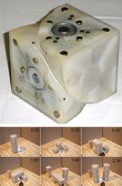Machine Copy
A simple robot builds a copy of itself block by block.
By Emily Sohn
It would be a perfect theme for a horror movie: People build robots that can make copies of themselves. Robots reproduce like crazy. Robots take over the world. Ridiculous?
In fact, only part of the story is fiction. Robots haven’t yet taken over the world, but scientists from Cornell University have created simple machines that can make more of their own kind. The process is called self-replication.
Far from being nightmarish, the researchers say, self-replicating robots could revolutionize space exploration. And they’d be perfect for clearing minefields and doing other risky tasks. Best of all, they’d be able to repair themselves.
 |
|
In frames from a video (bottom), a stack of special blocks of the type shown in the top image builds another stack just like it. The dots on some of the blocks’ faces are magnets and electrical contacts. |
| V. Zykov et al./Nature |
The new robots are made of stacks of blocks called “molecubes.” Each cube is about the size of an adult’s fist. Inside, there’s a motor, electromagnets, and a tiny computer processor.
The cubes are divided diagonally into plastic halves that can swivel back and forth. As a robot copies itself, computer programs tell the cube halves how to rotate. Electromagnets, meanwhile, let go of some cubes and pick up others that have been placed nearby.
During the process, the stack of cubes twists and bends into various shapes, such as L‘s or upside-down U‘s. In the end, there are two identical objects, where once there was just one.
This may not sound very impressive—yet. But it’s a step on the path toward complex machines that can make copies of themselves.—E. Sohn
Going Deeper:
Weiss, Peter. 2005. In its own image: Simple robot replicates itself block by block. Science News 167(May 14):310. Available at http://www.sciencenews.org/articles/20050514/fob7.asp .
You can learn more about self-replicating robots at www.mae.cornell.edu/ccsl/research/selfrep/index.htm (Cornell University).







